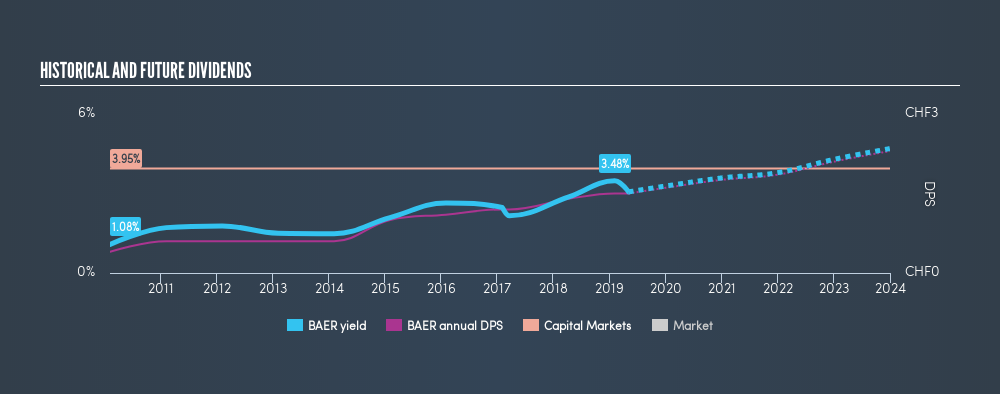- Switzerland
- /
- Capital Markets
- /
- SWX:BAER
How Does Julius Baer Group Ltd. (VTX:BAER) Stand Up To These Simple Dividend Safety Checks?

Want to participate in a short research study? Help shape the future of investing tools and you could win a $250 gift card!
Could Julius Baer Group Ltd. (VTX:BAER) be an attractive dividend share to own for the long haul? Investors are often drawn to a company for its dividend. If you are hoping to live on your dividends, it's important to be more stringent with your investments than the average punter. Regular readers know we like to apply the same approach to each dividend stock, and we hope you'll find our analysis useful.
With a goodly-sized dividend yield despite a relatively short payment history, investors might be wondering if Julius Baer Group is a new dividend aristocrat in the making. It sure looks interesting on these metrics - but there's always more to the story . The company also bought back stock equivalent to around 1.0% of market capitalisation this year. When buying stocks for their dividends, you should always run through the checks below, to see if the dividend looks sustainable.
Click the interactive chart for our full dividend analysis
Payout ratios
Dividends are usually paid out of company earnings. If a company is paying more than it earns, then the dividend might become unsustainable - hardly an ideal situation. As a result, we should always investigate whether a company can afford its dividend, measured as a percentage of a company's net income after tax. Julius Baer Group paid out 44% of its profit as dividends, over the trailing twelve month period. This is a middling range that strikes a nice balance between paying dividends to shareholders, and retaining enough earnings to invest in future growth. One of the risks is that management reinvests the retained capital poorly instead of paying a higher dividend.
We also measure dividends paid against a company's levered free cash flow, to see if enough cash was generated to cover the dividend. Julius Baer Group's cash payout ratio last year was 3.5%, which is quite low and suggests that the dividend was thoroughly covered by cash flow.
While the above analysis focuses on dividends relative to a company's earnings, we do note Julius Baer Group's strong net cash position, which will let it pay larger dividends for a time, should it choose.
Remember, you can always get a snapshot of Julius Baer Group's latest financial position, by checking our visualisation of its financial health.
Dividend Volatility
From the perspective of an income investor who wants to earn dividends for many years, there is not much point buying a stock if its dividend is regularly cut or is not reliable. Looking at the last decade of data, we can see that Julius Baer Group paid its first dividend at least nine years ago. The dividend has been quite stable over the past nine years, which is great to see - although we usually like to see the dividend maintained for a decade before giving it full marks, though. During the past nine-year period, the first annual payment was CHF0.40 in 2010, compared to CHF1.50 last year. This works out to be a compound annual growth rate (CAGR) of approximately 16% a year over that time.
We're not overly excited about the relatively short history of dividend payments, however the dividend is growing at a nice rate and we might take a closer look.
Dividend Growth Potential
The other half of the dividend investing equation is evaluating whether earnings per share (EPS) are growing. Over the long term, dividends need to grow at or above the rate of inflation, in order to maintain the recipient's purchasing power. Strong earnings per share (EPS) growth might encourage our interest in the company despite fluctuating dividends, which is why it's great to see Julius Baer Group has grown its earnings per share at 31% per annum over the past five years. With high earnings per share growth in recent times and a modest payout ratio, we think this is an attractive combination if earnings can be reinvested to generate further growth.
Conclusion
Dividend investors should always want to know if a) a company's dividends are affordable, b) if there is a track record of consistent payments, and c) if the dividend is capable of growing. First, we like that the company's dividend payments appear well covered, although the retained capital also needs to be effectively reinvested. Next, earnings growth has been good, but unfortunately the company has not been paying dividends as long as we'd like. Overall we think Julius Baer Group scores well on our analysis. It's not quite perfect, but we'd definitely be keen to take a closer look.
Earnings growth generally bodes well for the future value of company dividend payments. See if the 16 Julius Baer Group analysts we track are forecasting continued growth with our freereport on analyst estimates for the company.
If you are a dividend investor, you might also want to look at our curated list of dividend stocks yielding above 3%.
We aim to bring you long-term focused research analysis driven by fundamental data. Note that our analysis may not factor in the latest price-sensitive company announcements or qualitative material.
If you spot an error that warrants correction, please contact the editor at editorial-team@simplywallst.com. This article by Simply Wall St is general in nature. It does not constitute a recommendation to buy or sell any stock, and does not take account of your objectives, or your financial situation. Simply Wall St has no position in the stocks mentioned. Thank you for reading.
About SWX:BAER
Julius Bär Gruppe
Provides wealth management solutions in Switzerland, Europe, the Americas, Asia, and internationally.
6 star dividend payer and undervalued.
Similar Companies
Market Insights
Community Narratives





